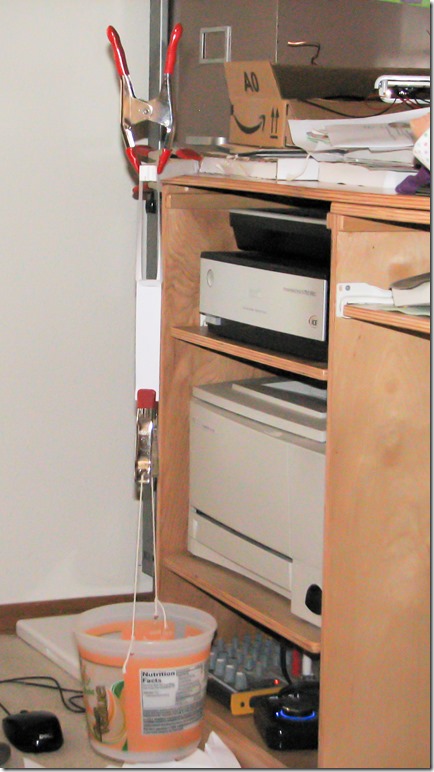Last summer I assigned my son, then six years old, to do an “inquiry.” Inquiries are guided studies of something, and empirical inquiries are like mini science fair projects. At the time I asked him to pick a topic he selected “how does glue work?” Exploring this at the chemistry level seemed like too big a reach for a 6 year old, so we morphed the question into “how well do different kinds of glue work?”
It turned out to be a really fun experiment. We gathered all the not-too-toxic glues from around the house. The oxiclean container has methyl cellulose inside.
He glued several trials of each paper together as crosses. Then, he brought the ends of the paper together and clamped, one piece of paper to a board hanging over the edge of the desk, and the other piece to bucket. In the picture below you can see the test setup. The paper is like two U-shapes that are glued where the come together. They don’t loop inside one another, they are held together only with glue. The glue joint area was approximately 1 inch square.
He added weight to the bucket until the paper failed, and then weighed the bucket.
The glues and results are in the table below. The “r” indicates that the paper ripped, otherwise the glue joint failed across the surface. The best and worst are boldface.
| # | Glue Name |
Average Weight Held (lbs.) |
Trial 1 | Trial 2 | Trial 3 |
| 1 | Elmer’s Glue Stick | 1.52 | 1.096 | 1.234 | 1.222 |
| 2 | PVA:Methyl Cellulose 1:1 vol. | 2.37 | 3.064 | 2.888 | 2.062 |
| 3 | Elmer’s Glue-All | 3.39 | 3.270 | 3.944 (r) | 2.928 |
| 4 | Gorilla Glue | 2.27 | 5.438 | 3.180 | 0.746 |
| 5 | Methyl Cellulose | 4.20 | 4.468 | 4.392 | 3.752 |
| 7 | PVA | 3.65 | 3.966 | 2.768 | 3.824 |
| 8 | Titebond III | 4.25 | 3.824 | 5.180 | 3.576 |
| 9 | DAP Strongstick | 1.54 | 1.460 | 1.562 | 1.576 |
| 10 | Cyanoacrylate (Super Glue) | 4.15 | 5.180 | 3.966 (r) | 3.284 (r) |
Most of these results fit my expectations. There were a few surprises though.
- Gorilla glue (polyurethane) was typically quite strong, but once was very poor.
- Methyl cellulose is usually considered a weak glue, but it performed almost as well as the best of them. Maybe it is strong in our dry climate and weaker in more humid climates?
- Glues that soak in well (super glue and methyl cellulose) seem to have an advantage.
The test was essentially performing a sort of peel-off strength test. In many ways I think the setup was quite good. The stresses on the glue joint are fairly typical for what materials are stressed with.



Comments
One response to “Glue on Paper”
Very cool experiments! If he wants to dig further, you could see how things work with different materials. Take the best 2 and worst 2 adhesives and do a similar test with paper, plastic and wood (or something along those lines). That would answer the question of whether it’s the fact that they soak in that helps certain ones.